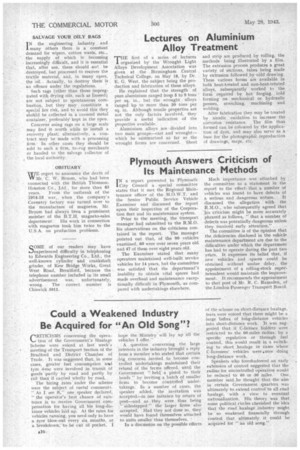Lectures on Aluminium Alloy Treatment
Page 18

If you've noticed an error in this article please click here to report it so we can fix it.
THE first of a series of lectures organized by the Wrought Light Alloys Development Association was given at the Birmingham Central Technical College, on May 18, by Dr. E. G. West, the subject being the production and fabrication of these alloys.
He explained that the strength of pure aluminium ranged from. 5 to 9 tons per sq. in., but the wrought alloys ranged hp to more than 30 tons per sq. in. Although tensile properties are not the only factors involved, they provide a useful indication of the properties available.
Aluminium alloys are divided into two main groups—cast and wrought— which he summarized so far as the wrought forms a re concerned. Sheet and strip are produced by rolling, the methods being illustrated by a film. The extrusion process produces a great variety of sections, tubes being made by extrusion followed ,by cold drawing. These various forms are• available in both heat-treated and non-heat-treated alloys, subsequently worked to the form required by hot forging, cold forming on mechanical or hydraulic presses, stretching, machining and welding.
After fabrication they may be treated by anodic oxidation to increase the corrosion resistance. The film thus formed can be coloured by the application of dyes, and may also serve as a base for the photographic reproduction of drawings, maps, etc.




















































